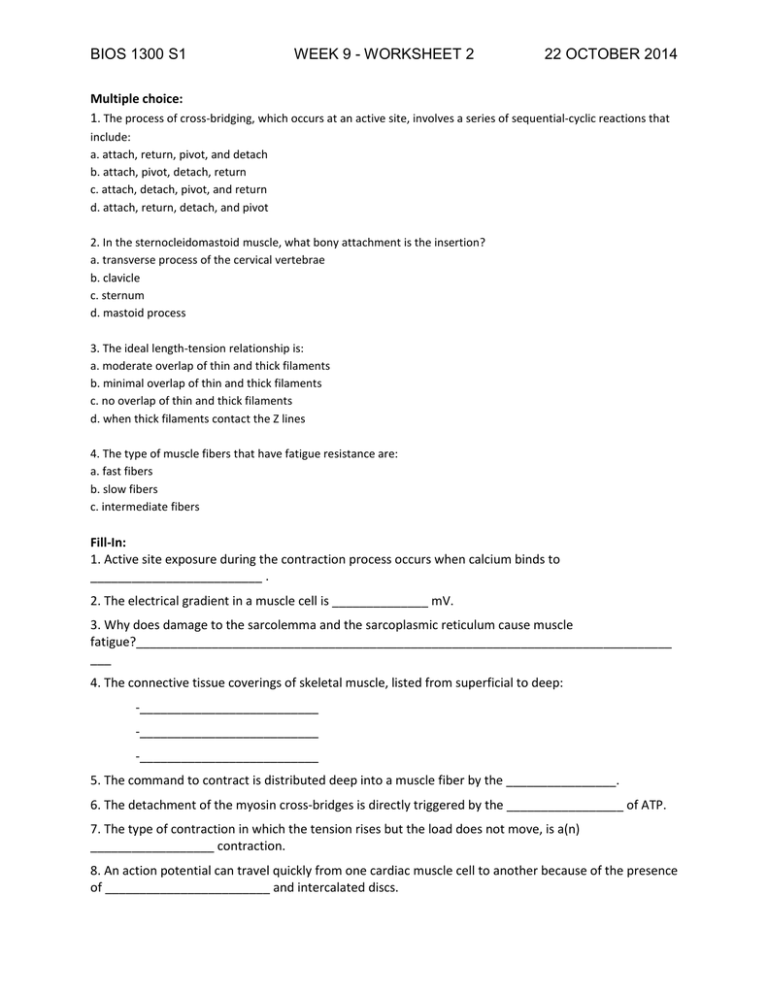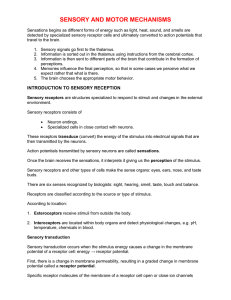BIOS 1300 S1 WEEK 9 - WORKSHEET 2 22 OCTOBER 2014
advertisement

BIOS 1300 S1 WEEK 9 - WORKSHEET 2 22 OCTOBER 2014 Multiple choice: 1. The process of cross-bridging, which occurs at an active site, involves a series of sequential-cyclic reactions that include: a. attach, return, pivot, and detach b. attach, pivot, detach, return c. attach, detach, pivot, and return d. attach, return, detach, and pivot 2. In the sternocleidomastoid muscle, what bony attachment is the insertion? a. transverse process of the cervical vertebrae b. clavicle c. sternum d. mastoid process 3. The ideal length-tension relationship is: a. moderate overlap of thin and thick filaments b. minimal overlap of thin and thick filaments c. no overlap of thin and thick filaments d. when thick filaments contact the Z lines 4. The type of muscle fibers that have fatigue resistance are: a. fast fibers b. slow fibers c. intermediate fibers Fill-In: 1. Active site exposure during the contraction process occurs when calcium binds to _________________________ . 2. The electrical gradient in a muscle cell is ______________ mV. 3. Why does damage to the sarcolemma and the sarcoplasmic reticulum cause muscle fatigue?______________________________________________________________________________ ___ 4. The connective tissue coverings of skeletal muscle, listed from superficial to deep: -__________________________ -__________________________ -__________________________ 5. The command to contract is distributed deep into a muscle fiber by the ________________. 6. The detachment of the myosin cross-bridges is directly triggered by the _________________ of ATP. 7. The type of contraction in which the tension rises but the load does not move, is a(n) __________________ contraction. 8. An action potential can travel quickly from one cardiac muscle cell to another because of the presence of ________________________ and intercalated discs. BIOS 1300 S1 WEEK 9 - WORKSHEET 2 22 OCTOBER 2014 9. According to the ____________—_____________ relationship; the greater the zone of overlap in the sarcomere, the greater the tension the muscle can develop and there is an optimum range of actin and myosin overlap that will produce the greatest amount of tension, which is ________________ overlap 10. The more moveable end of a muscle is the _______________. 11. The muscles of the facial expressions are innervated by CN _______. 12. The major extensor of the elbow is the ____________________ muscle. 13. Mary’s newborn is having trouble sucking. The doctor suggests it may be a problem with a particular muscle. The muscle the doctor may be referring to would be the _______________. 14. The primary determinant of a resting membrane potential is the membrane permeability to _________________. 15. Receptors that bind acetylcholine at the post synaptic membrane are _____________ gated channels. 16. If the resting membrane potential is -70mV and the threshold is -55mV, a membrane potential of 60mV will make is ___________ to produce an action potential. Matching: Using the key choices, select the terms defined in the following statements. Write the correct answers in the answer blanks. Terms may be used more than once or not at all, but there is only one letter for each statement. A. Absolute refractory period E. Graded potential I. Repolarization B. Action potential F. Hyperpolarization J. Sodium-potassium pump C. Depolarization G. Resting potential D. Threshold H. Relative refractory period __________ 1. Corresponds to the period of repolarization of the neuron. __________ 2. Results from the opening of voltage-regulated gates. __________ 3. State of an unstimulated neuron’s membrane. __________ 4. An all-or-none event. __________ 5. Period when a neuron cannot be restimulated because its sodium gates are open and an action potential is being generated. __________ 6. Mechanism by which ATP is used to move sodium ions out of the cell and potassium ions into the cell; completely restores and maintains the resting conditions of the neuron. __________ 7. Point at which the axon “fires”. __________ 8. Self-propagated depolarization. __________ 9. Results from the opening of chemically regulated gates. __________10. A voltage change that reduces the ability of a neuron to conduct an impulse; the membrane potential becomes more negative. BIOS 1300 S1 WEEK 9 - WORKSHEET 2 22 OCTOBER 2014 __________ 11. A local change in membrane potential in which current flow is quickly dissipated, that is, decremental. __________ 12. A voltage change that brings a neuron closer to its threshold for firing; the membrane potential becomes less negative. Short Answer: 1. What structural feature of skeletal muscle fiber is responsible for conducting action potentials into the interior of the cell? 2. What five interlocking steps are involved in the contraction process? 3. Atracurium is a drug that blocks the binding of ACh to receptors. Give an example of a site where such binding normally occurs, and predict the physiological effect of this drug. 4. Explain why a murder victim’s time of death can be estimated according to the flexibility or rigidity of the body. 5. What is the functional difference among voltage-gated, chemically gated, and mechanically gated channels 6. State the all-or-none principle of action potentials.






